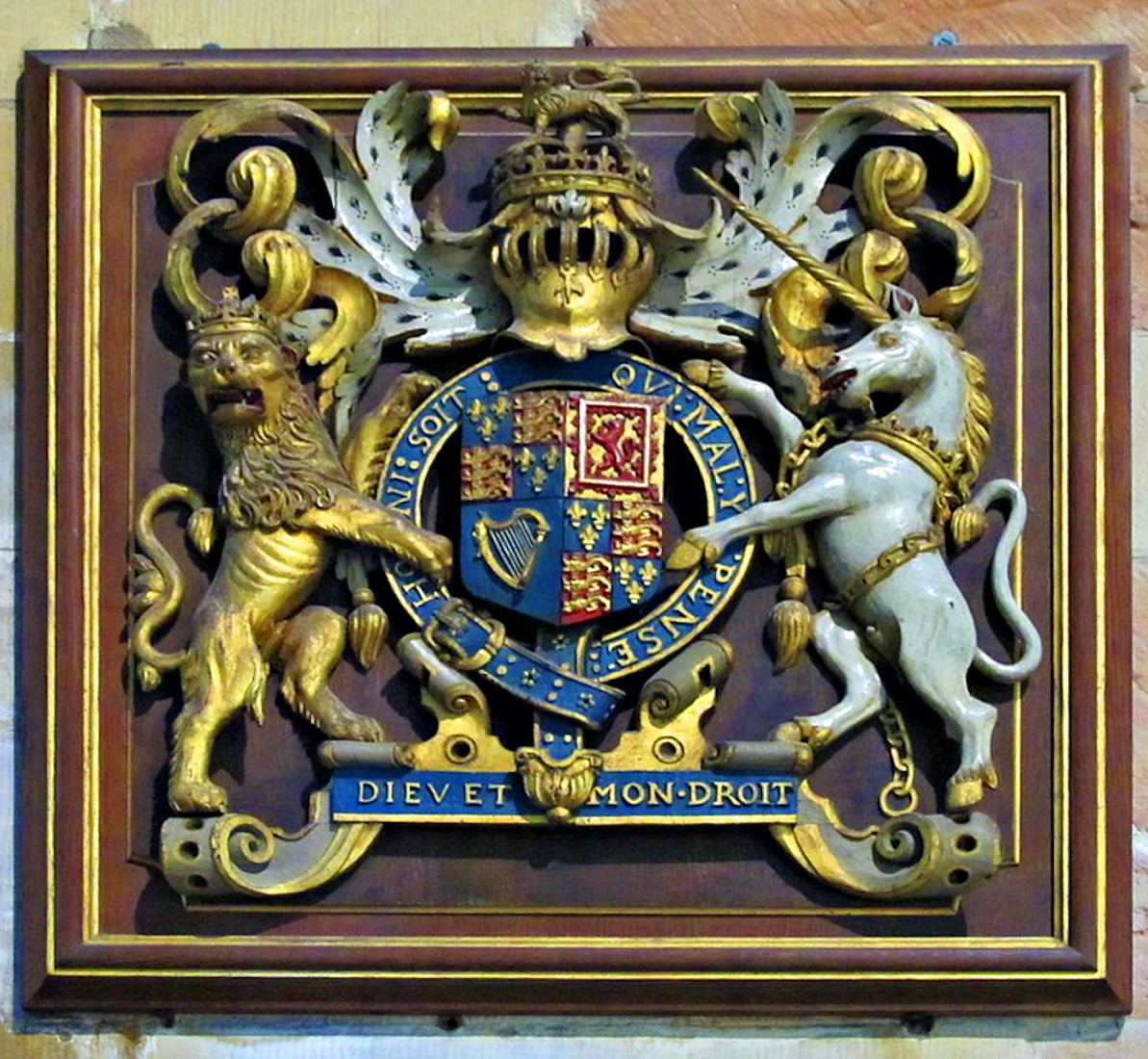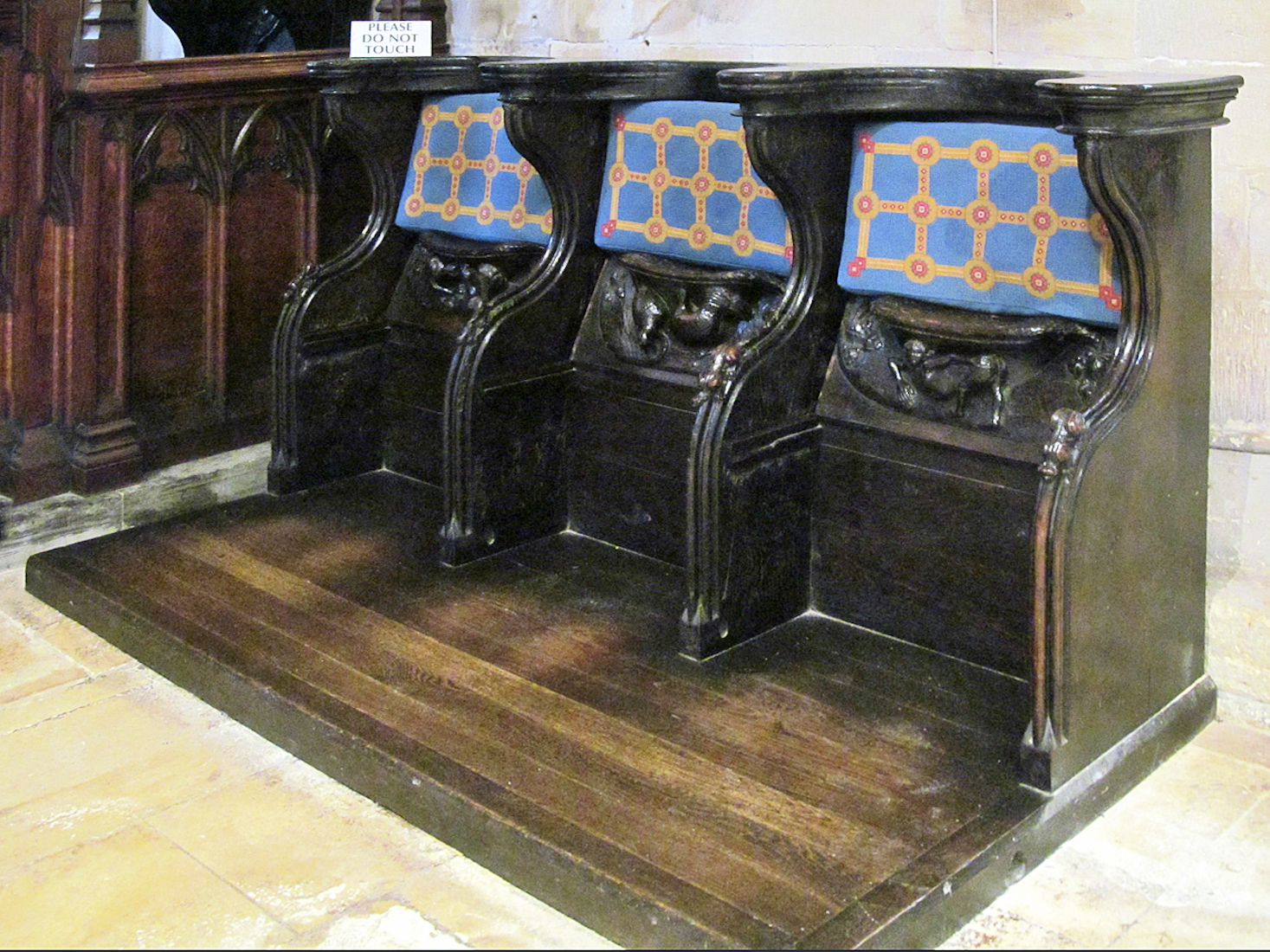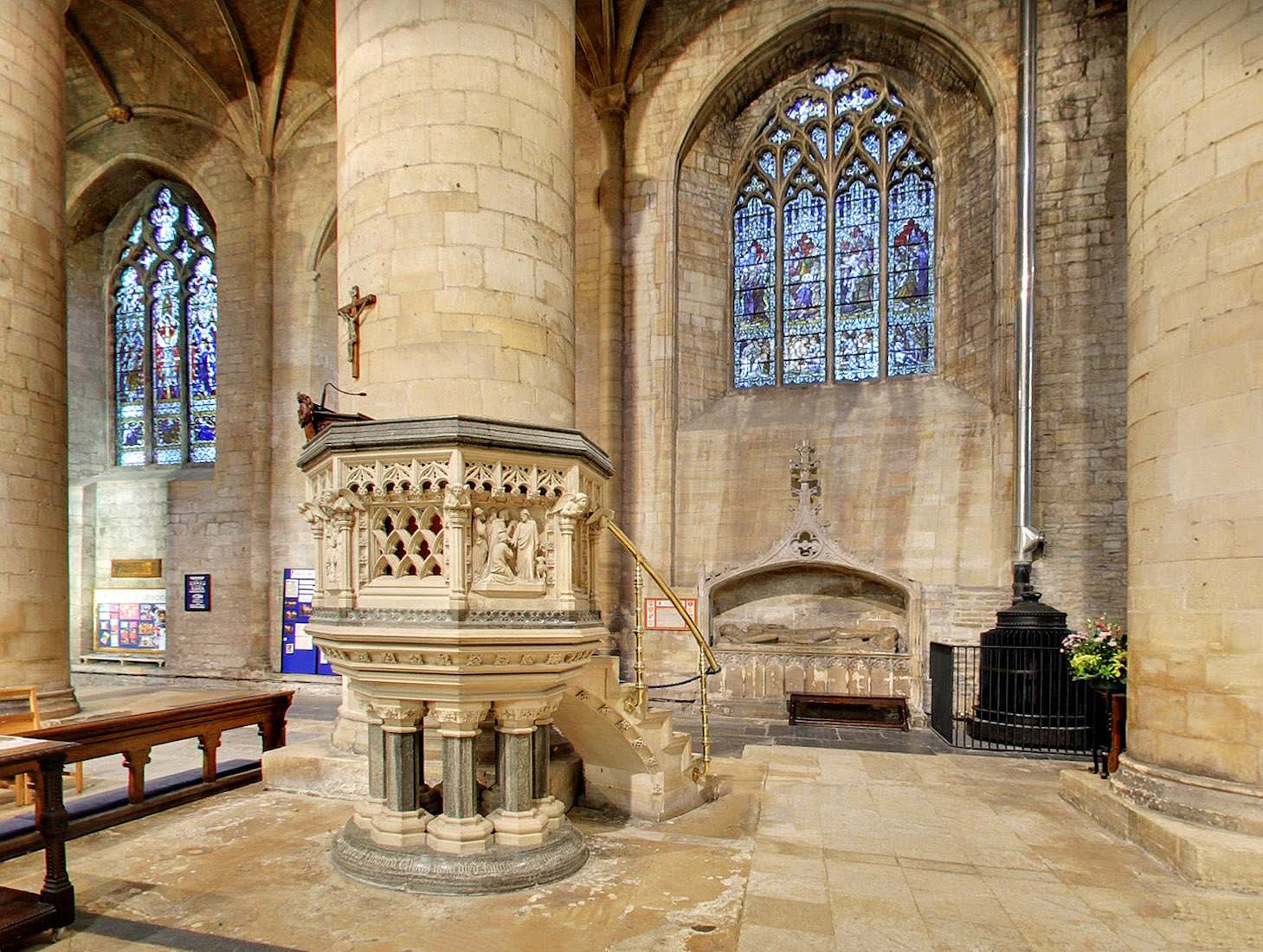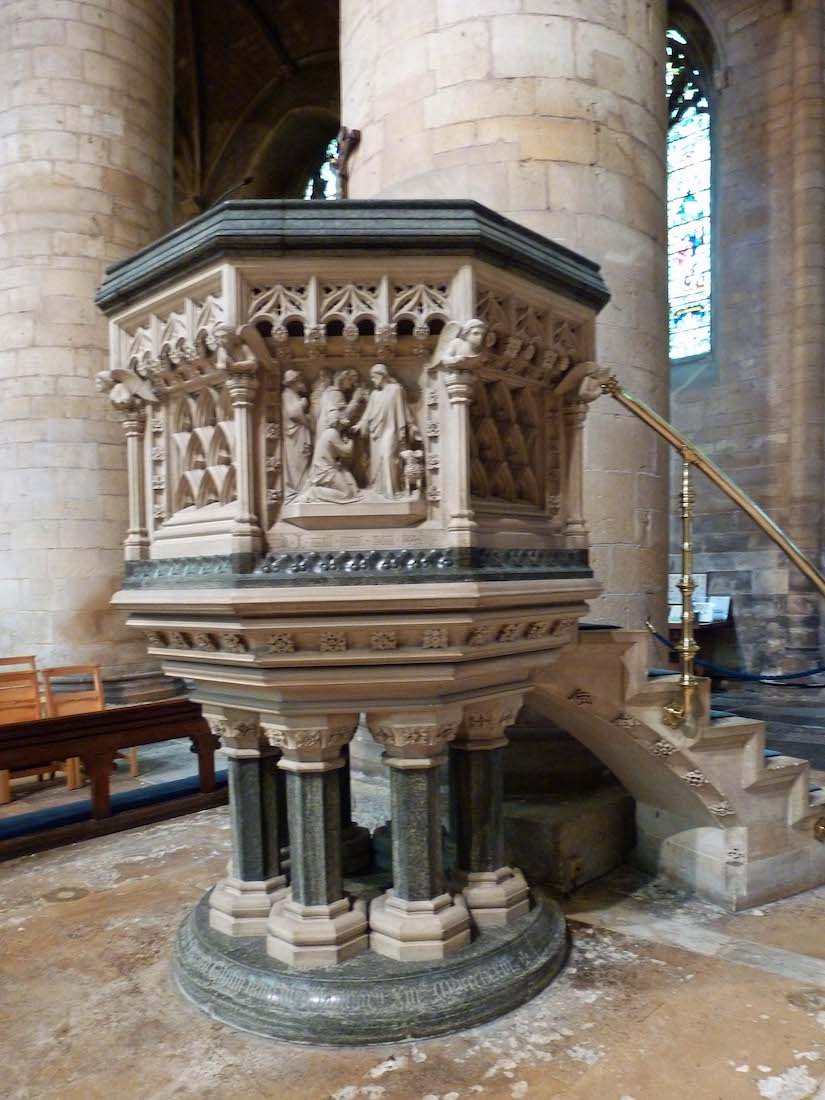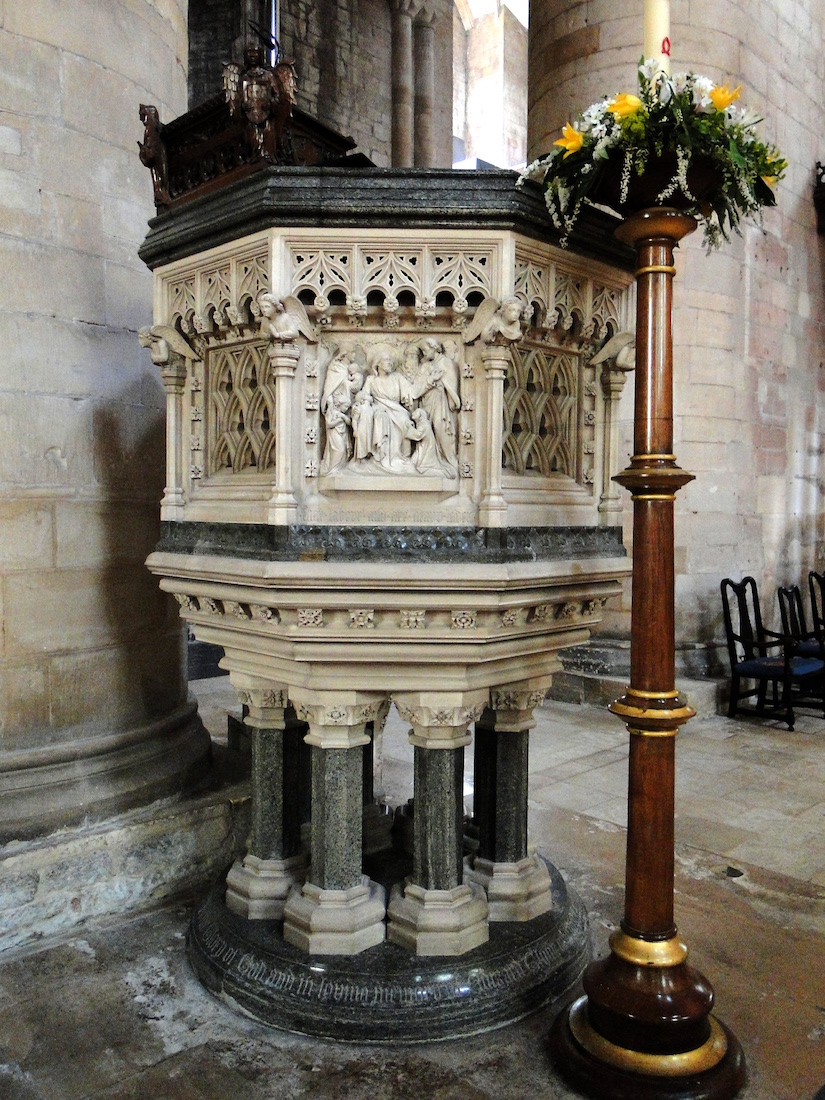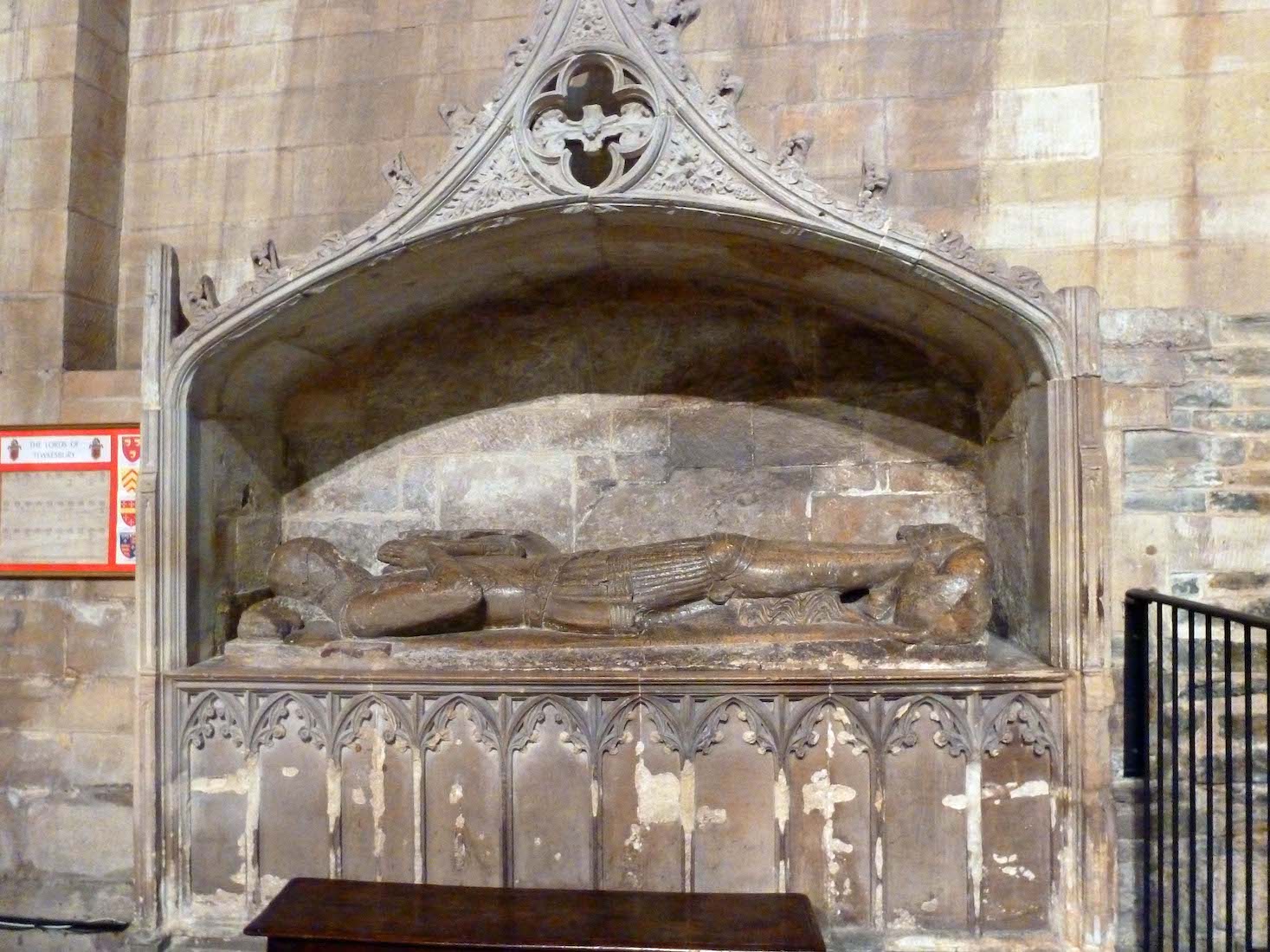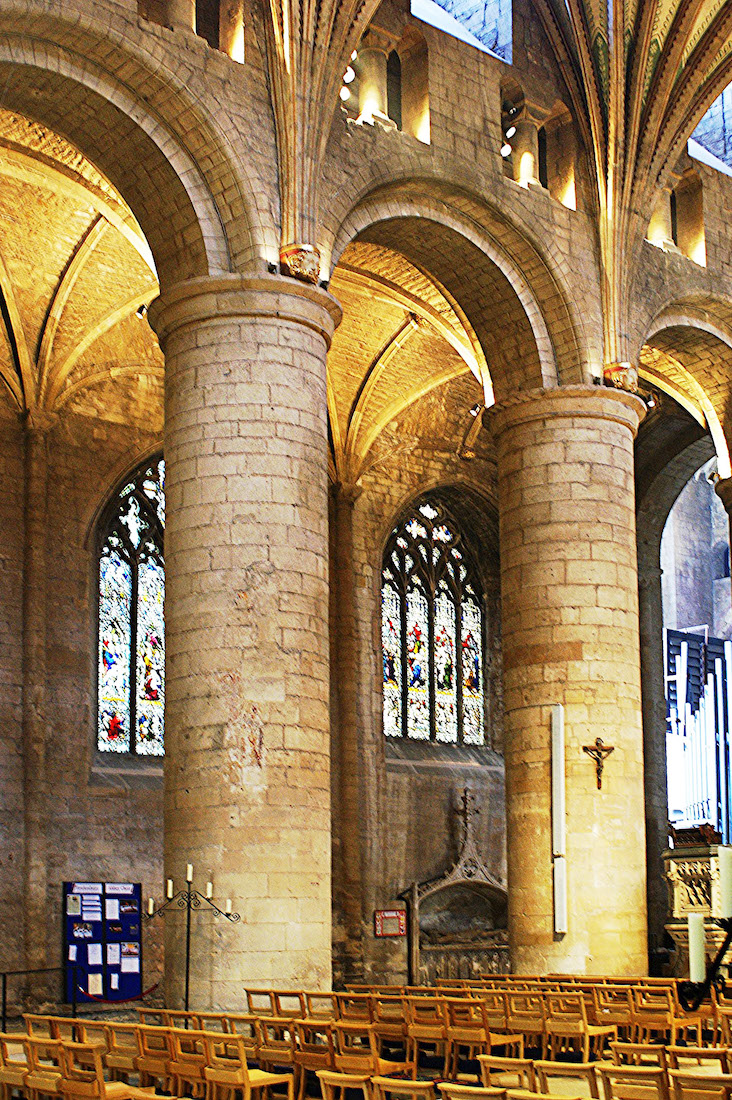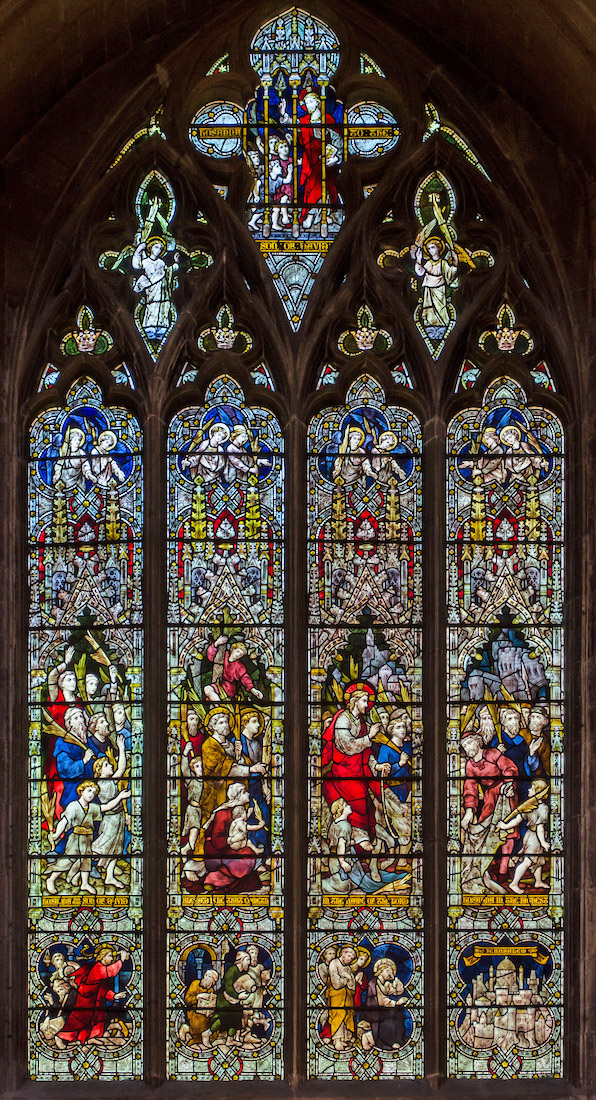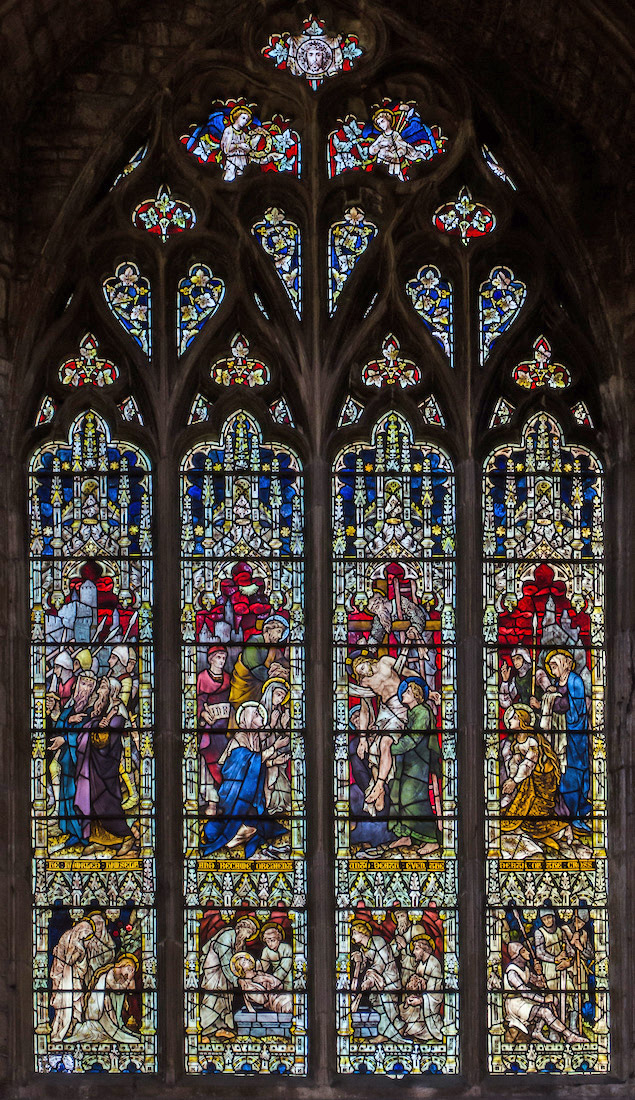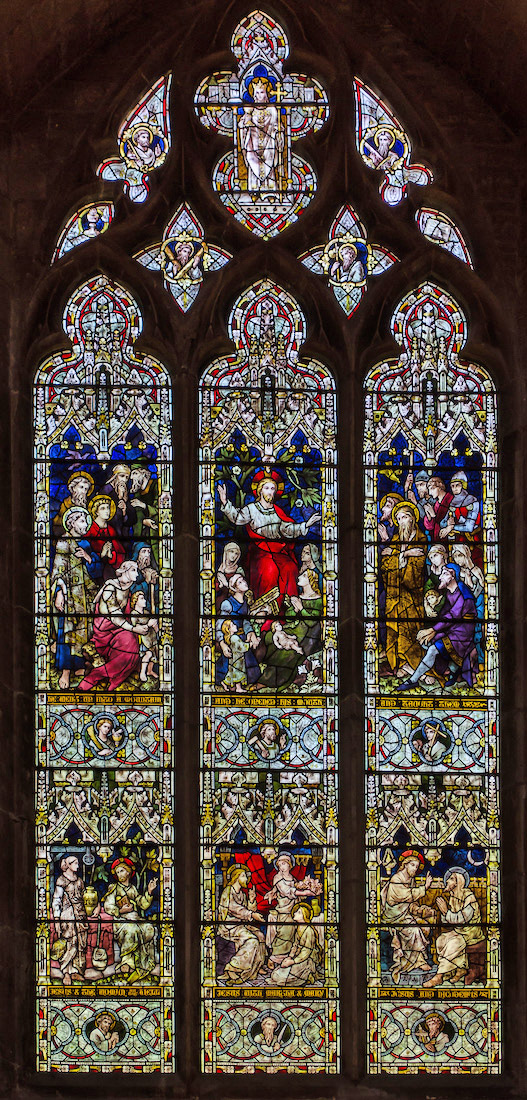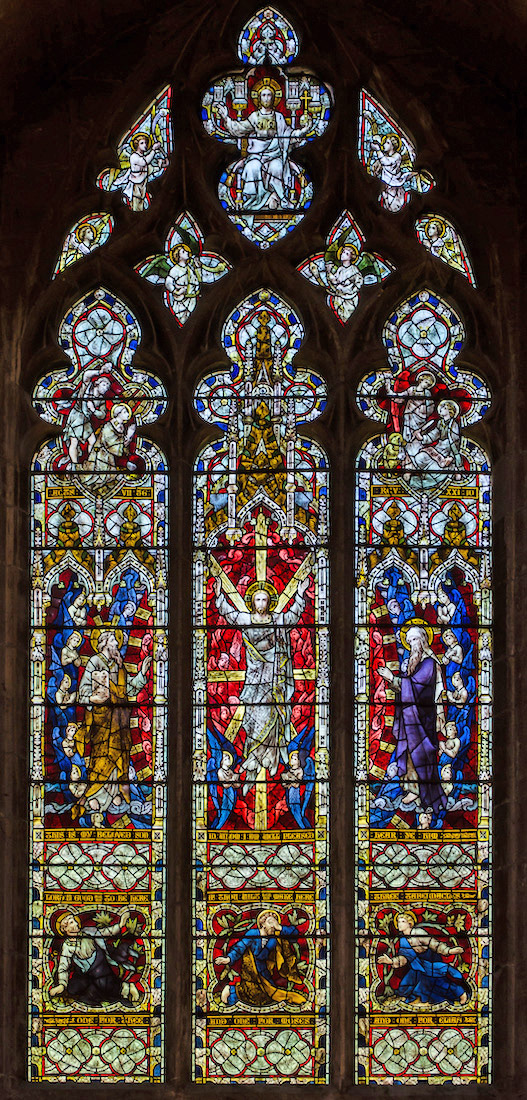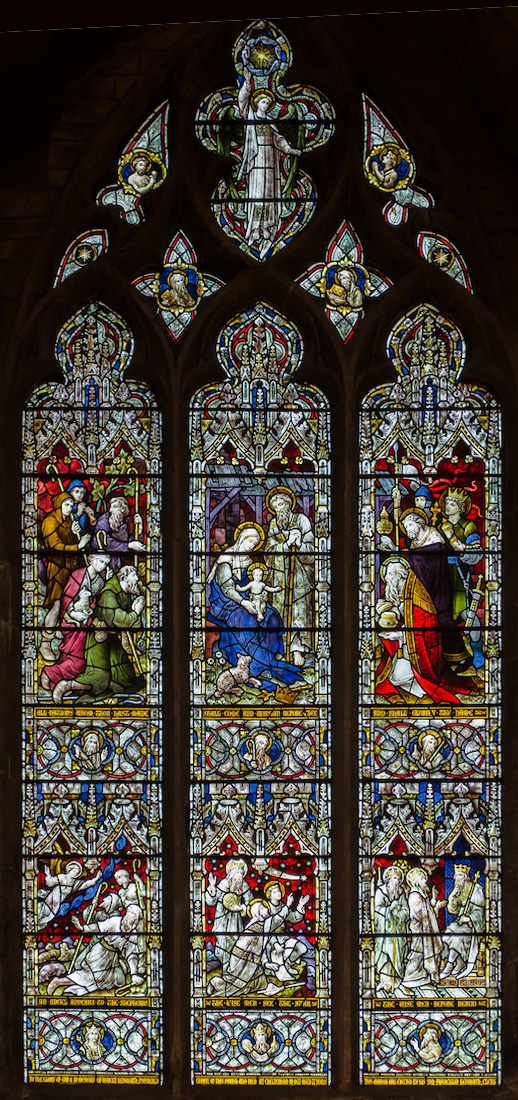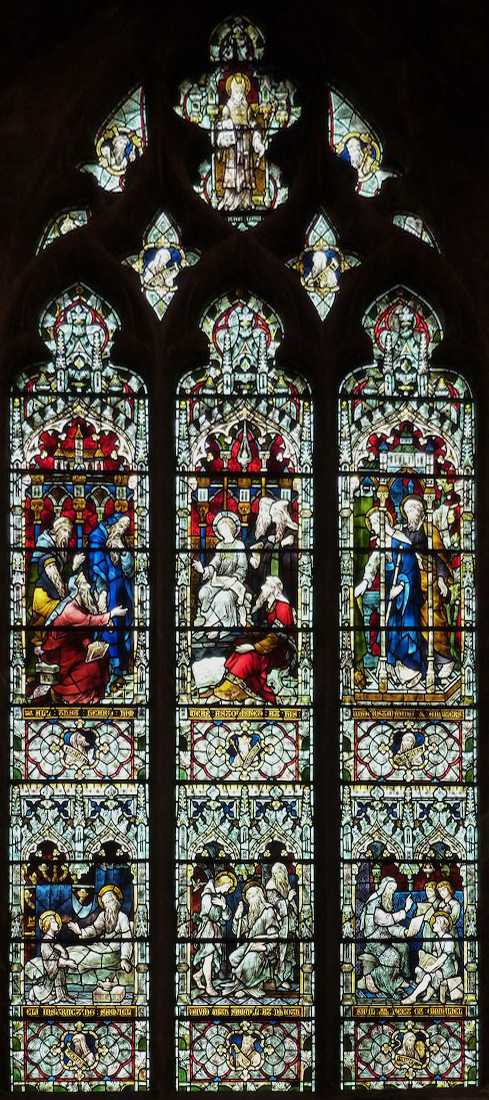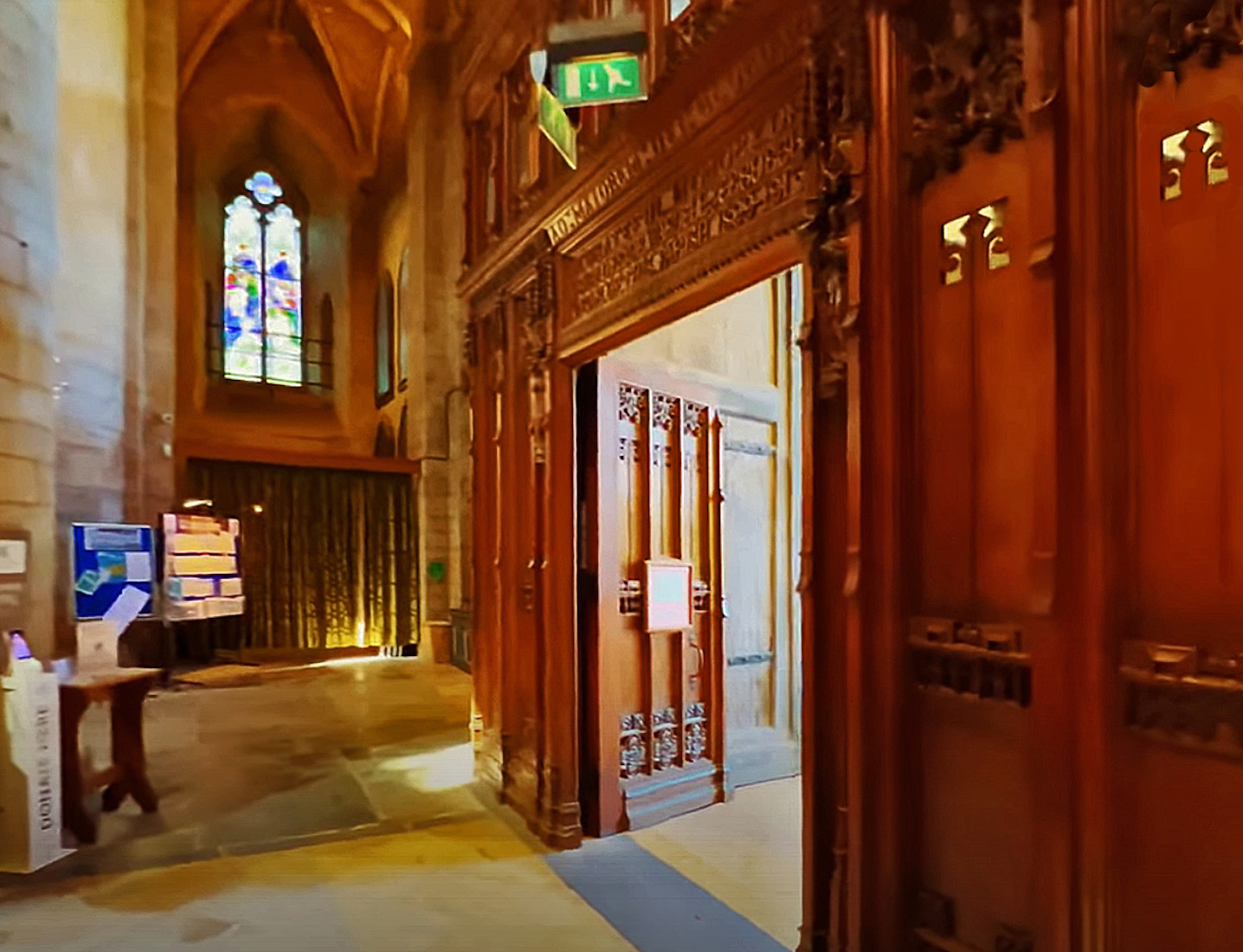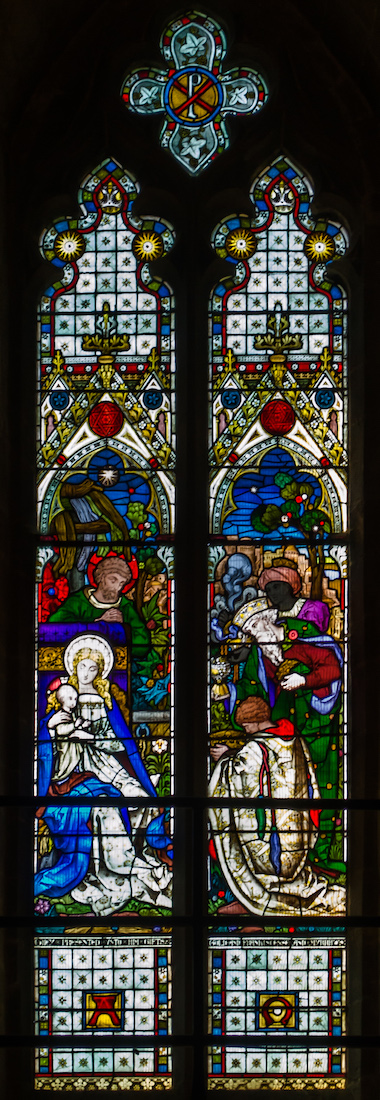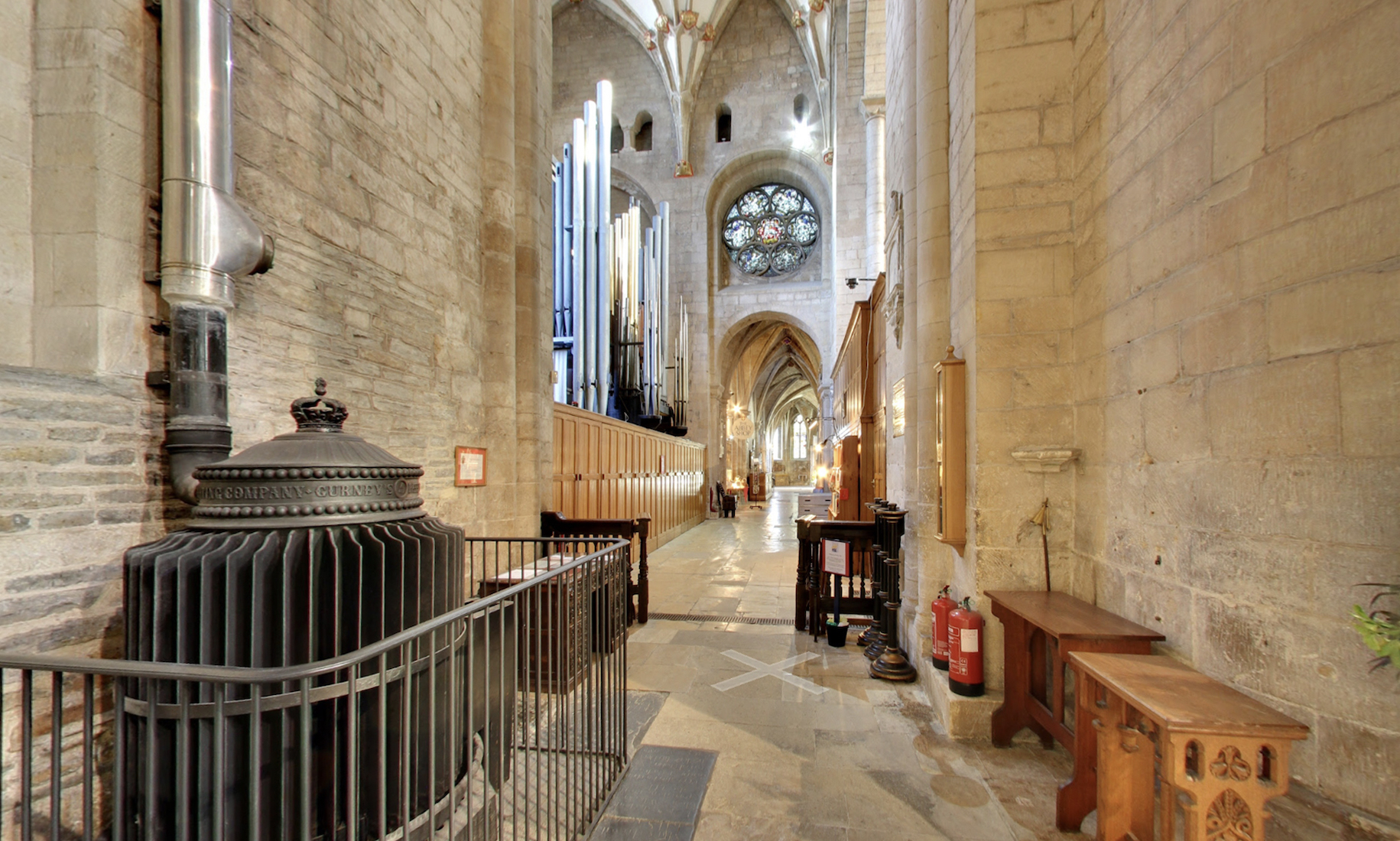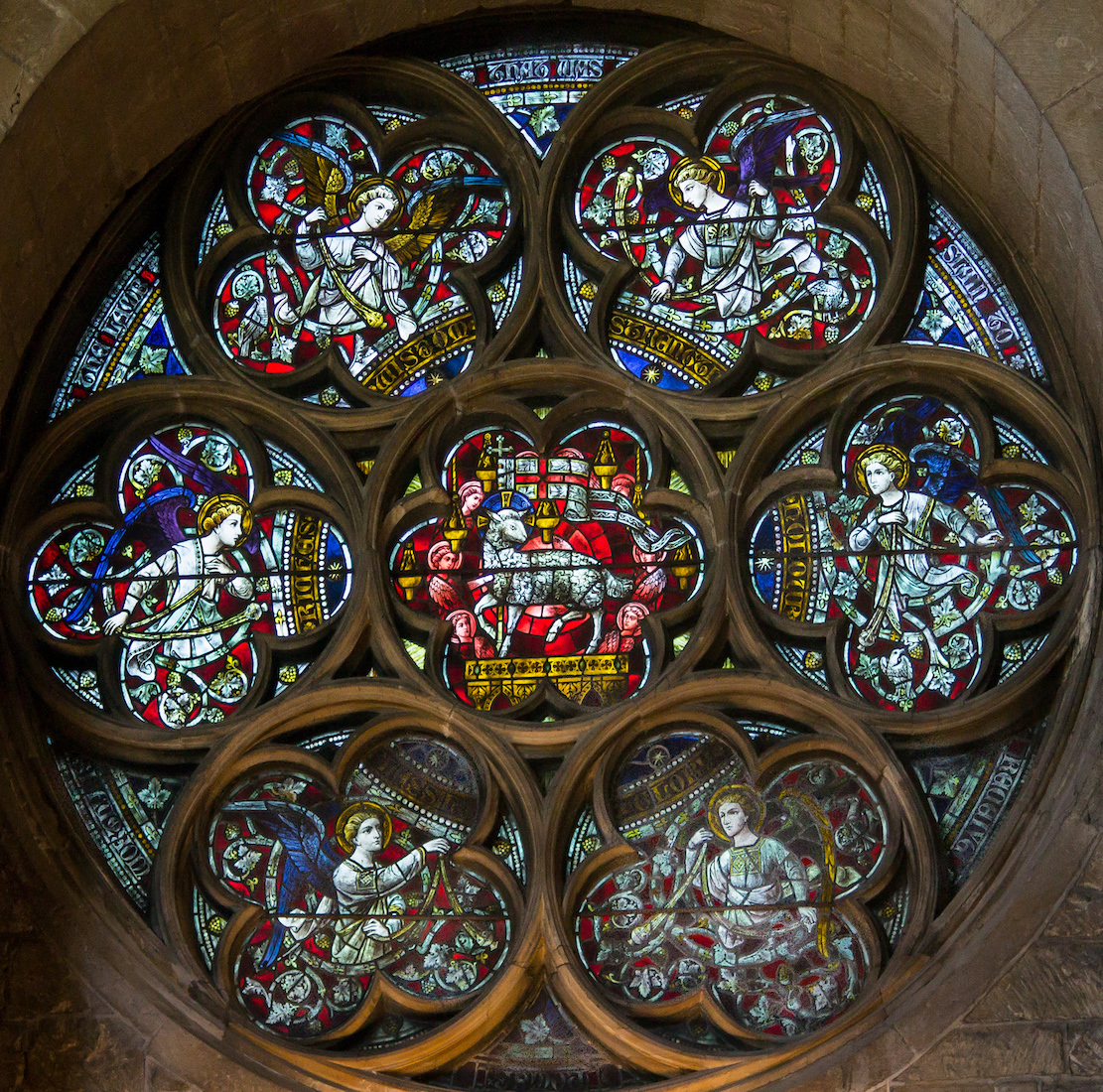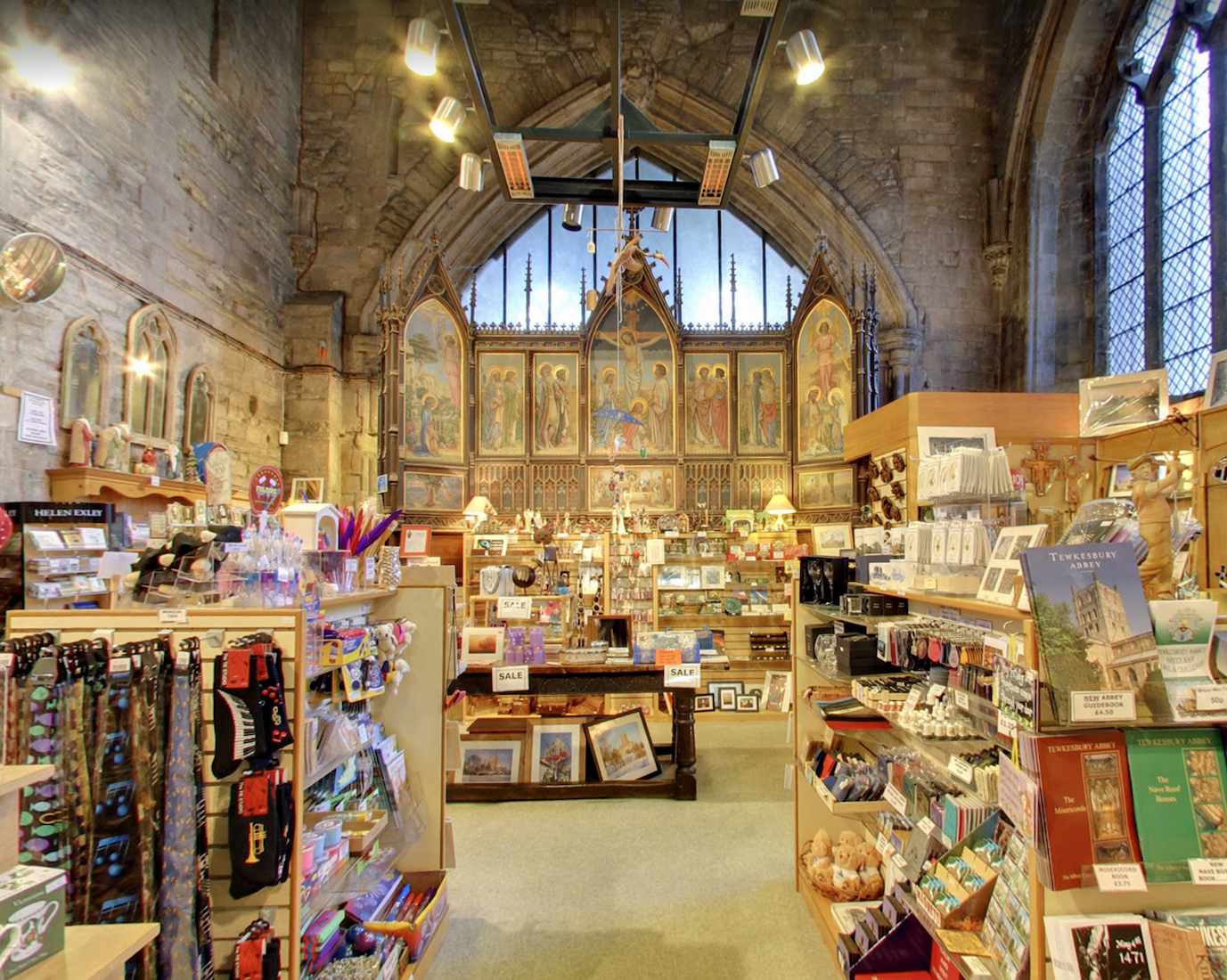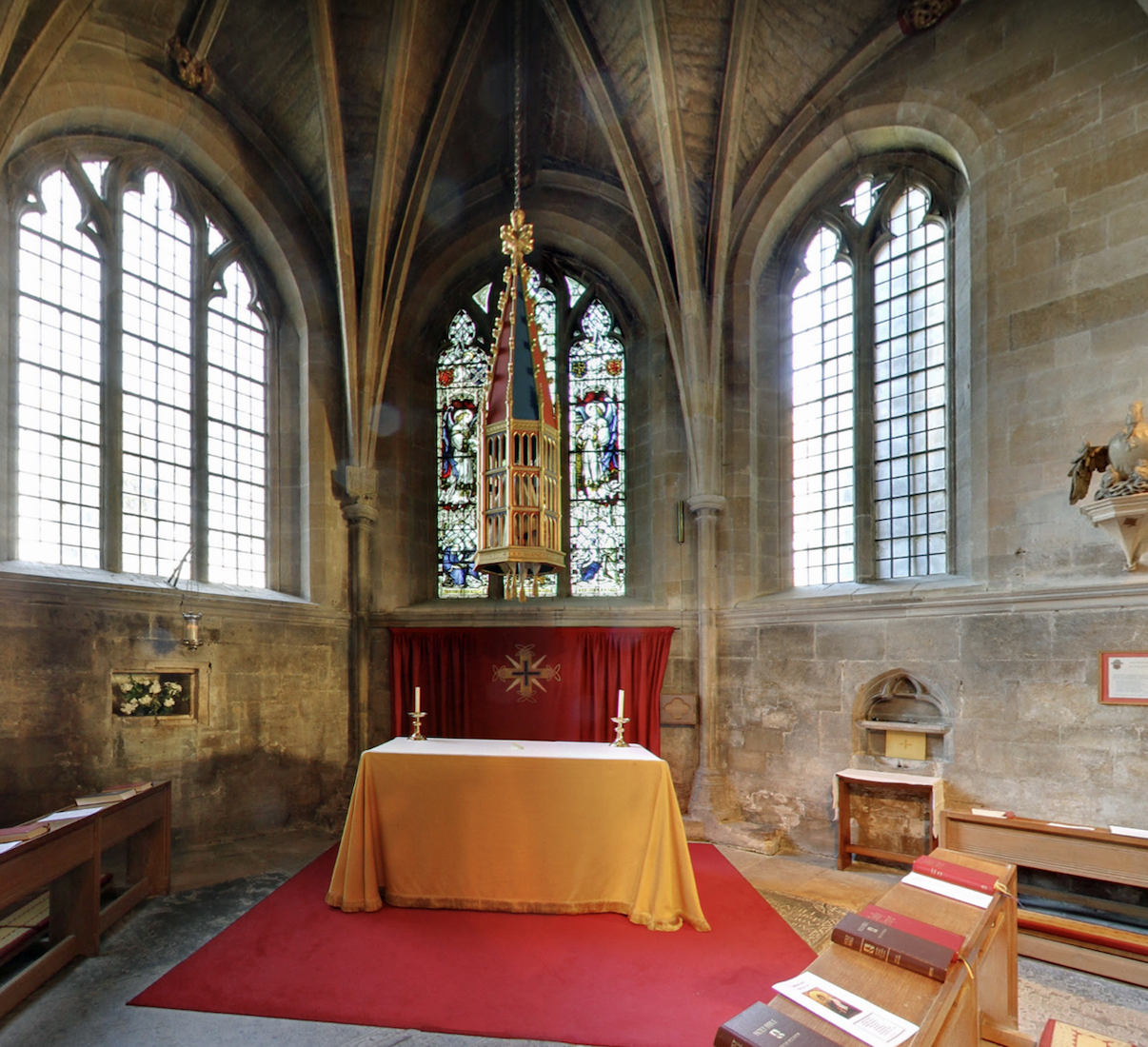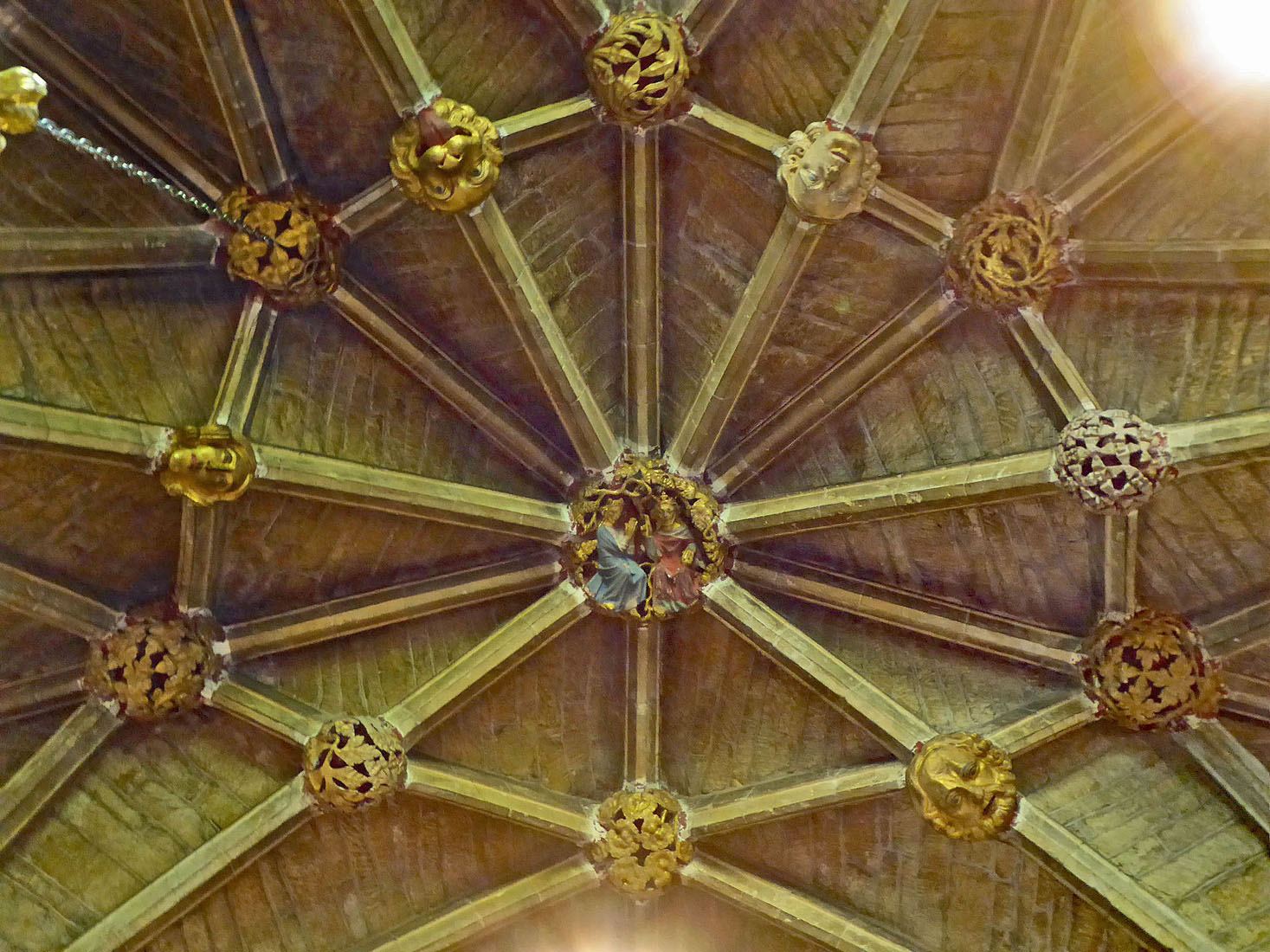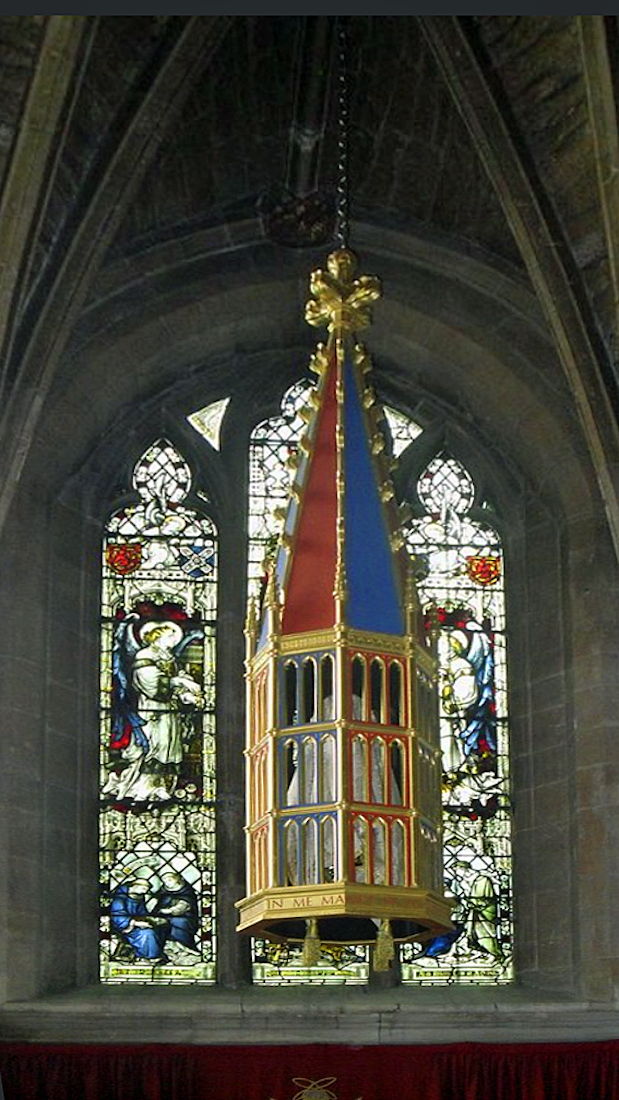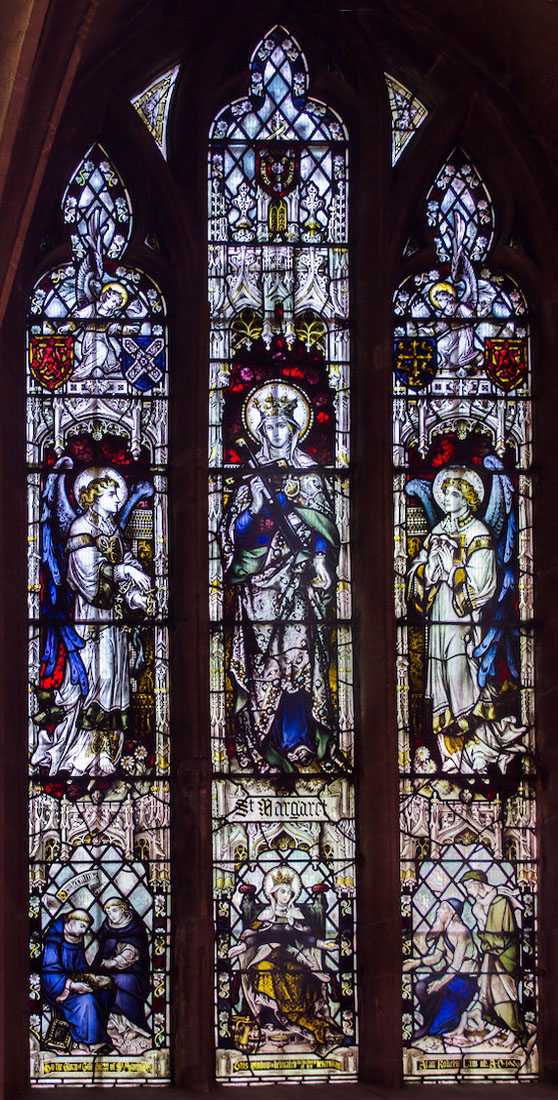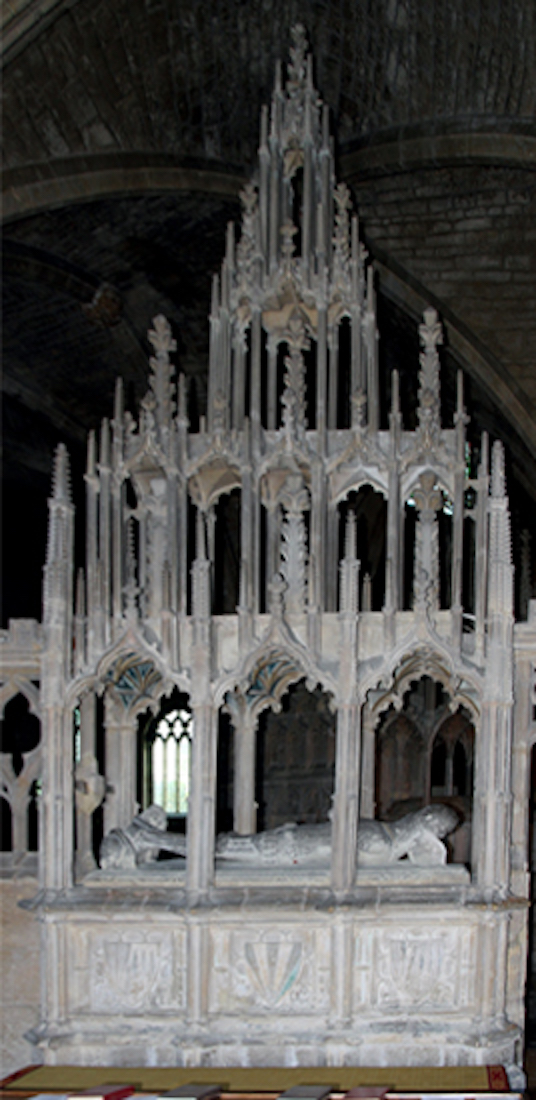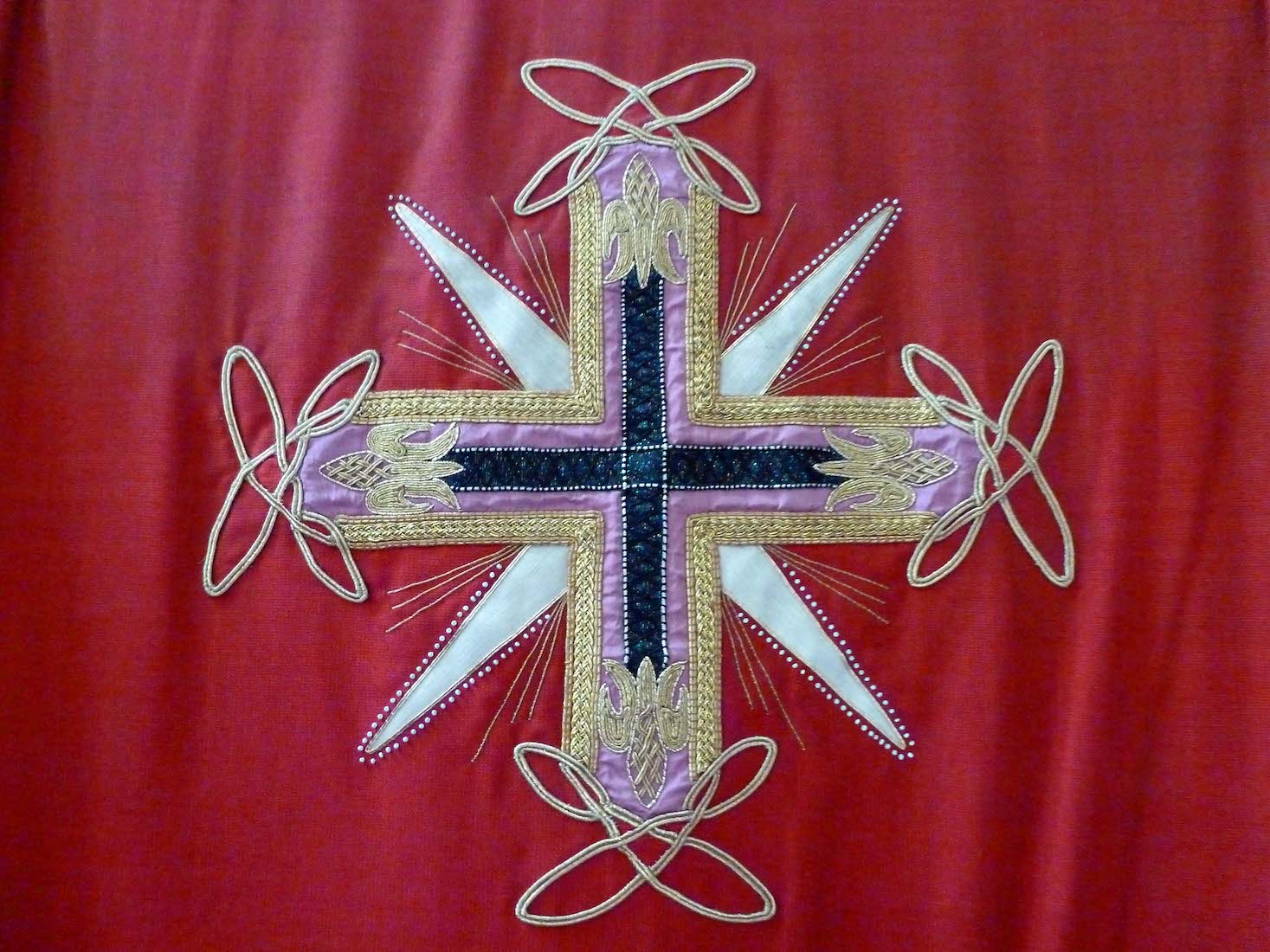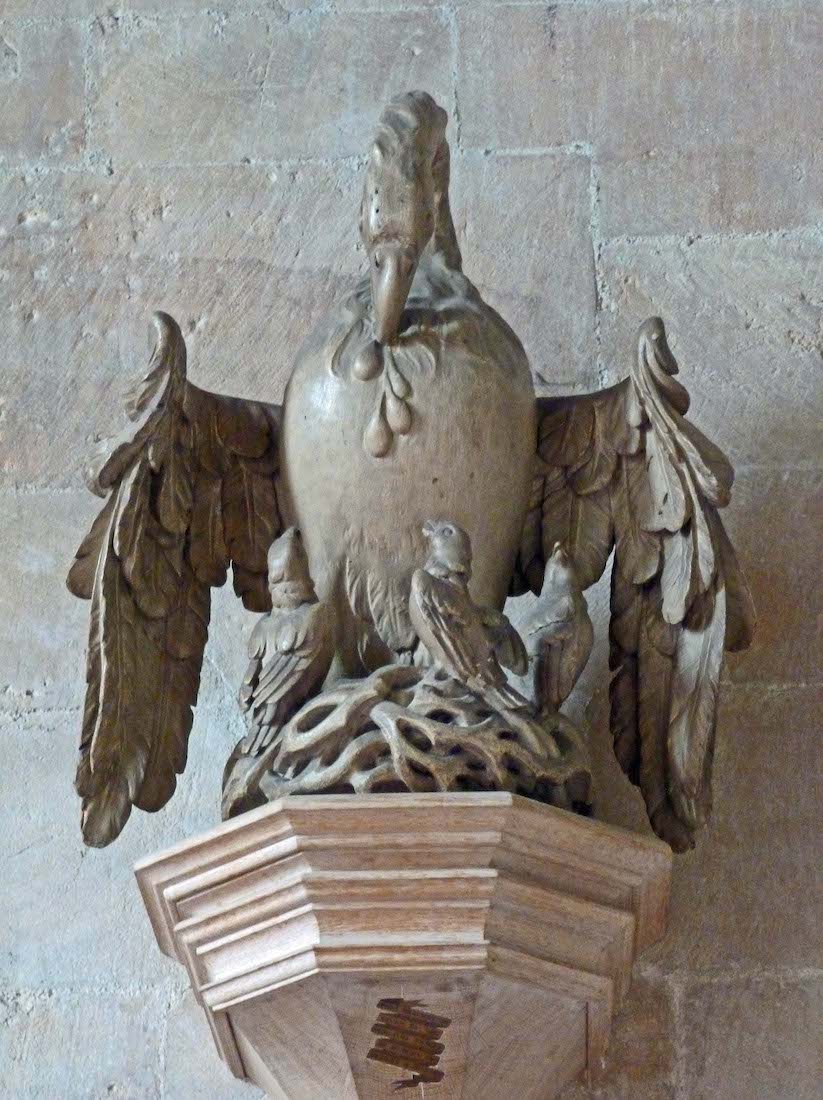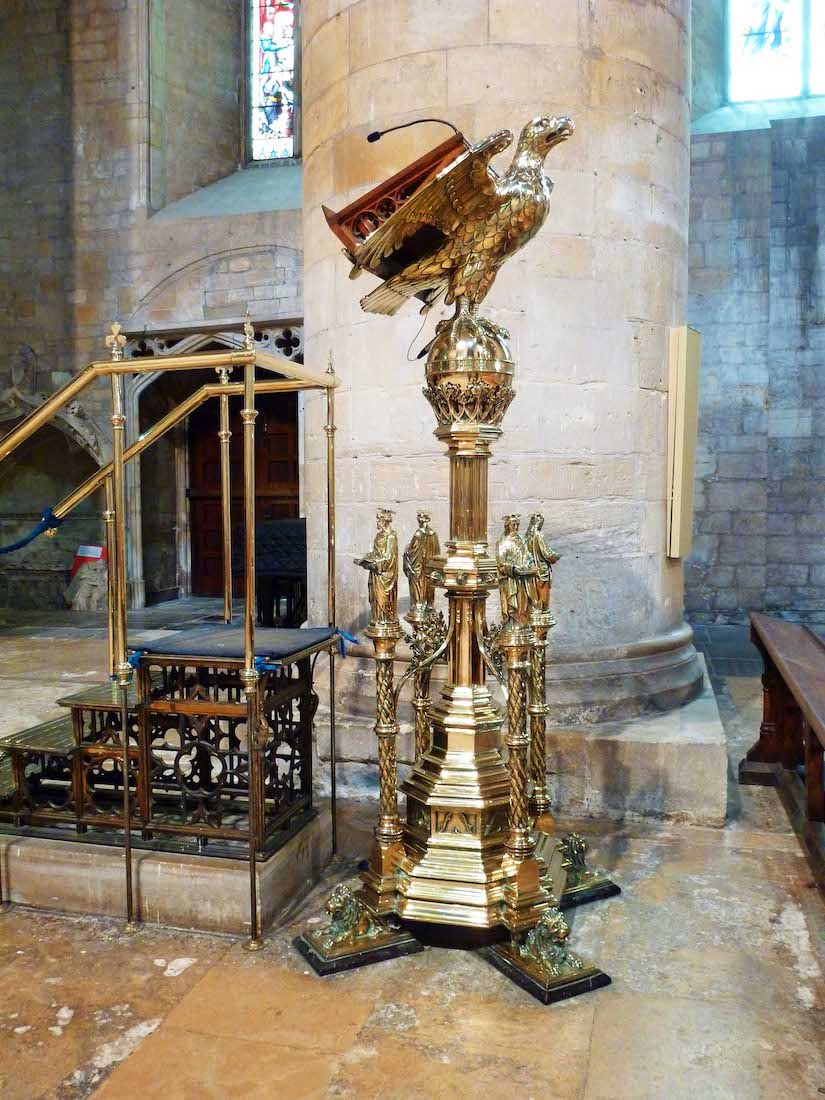
The splendid eagle lectern was donated by Rev. Charles W. Grove, in memory of his wife. As stated on the orb, it was presented during Easter 1878. The lectern is of standard design with the Bible resting on the outspread wings of an eagle which is standing on an orb. However this lectern also has a highly decorated base, with four standing figures which are sure to be the Four Evangelists, and all supported by four lions. INDEX
42. SOUTH NAVE WINDOW 5 J&J
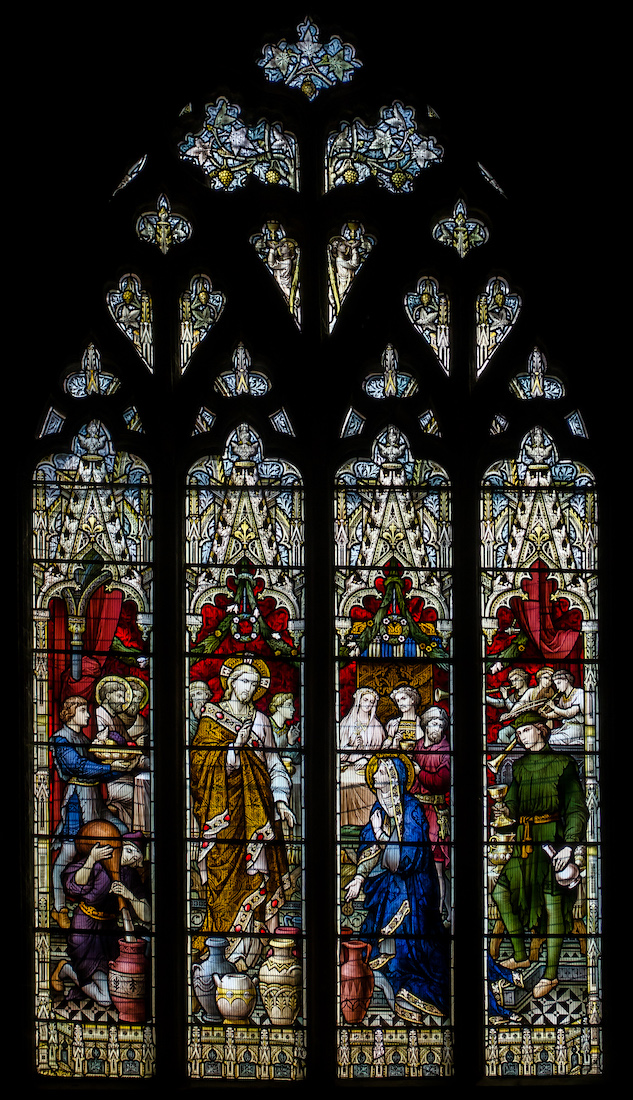
The last of the beautiful windows on the South wall shows Jesus at the Marriage at Cana, with the story related in John 2:1–11. The party has run out of wine, and Mary the Mother of Jesus (in blue) implores Jesus to turn water into wine. This is one of a series of five Miracle windows by Hardman & Co, 1888. It was donated by Rev Charles Grove.
43. ROYAL COAT OF ARMS WH
The royal coat of arms in its various guises, usually supported by a lion and a unicorn, began to appear in English churches and cathedrals in the aftermath of the English Reformation – a reminder to congregations that the monarchy was in charge of matters spiritual as well as temporal.
44. MISERICORDS WH
Visible under the raised seats of the choir stalls are three misericords. Misericords were carved ledges designed to help the early monks stand upright during long masses. The carvings were very much at the discretion of the carver: funny, reverend, sometimes sacrilegious! Tewkesbury has sixteen 14th century misericords. They can all be viewed here.
45. NAVE – TO THE WEST WH
Standing at the front of the nave we can look back and appreciate the grand dimensions of this sacred space.
46. ACROSS TO THE PULPIT GSV
Moving towards the North side of the nave, we come to the pulpit. This is C19th and of carved stone. Beyond the pulpit we observe a niche in the North wall containing an effigy, with a large stained glass window above.
47. PULPIT GA RH
The pulpit has panels showing Christ with his disciples and also Christ preaching.
48. KNIGHT EFFIGY GA
The effigy is of an unknown knight, and dates from ca 1365.
49. NAVE COLUMNS AND NORTH WALL HL
If we look across the nave to the North wall, we see that there are in fact seven windows along this wall, six East of the North entry, and a further plain window on the West side. As with the South nave wall, apart from the effigy, this wall is relatively unadorned, and the interest is in the fine windows. [Photo Credit: Wikimedia Hugh Llewelyn]
50. NORTH NAVE WINDOWS 6,7 J&J J&J
We investigate the North nave windows, beginning at the East end. ••• The window at left shows the Entry into Jerusalem, by Hardman & Co, 1892. Jesus enters Jerusalem sitting unrealistically on a donkey, surrounded by people with palms. The story is told in John 12:12–7. Notice how the vertical window divisions coincide with the trunks of palm trees. Below are four panels showing Jesus and the money-lenders, Jesus weeping over Jerusalem and the walled city itself. ••• The window at right shows the body of Jesus being lowered from the Cross. It is called Descent from the Cross, by Hardman & Co, 1892, and is one of a series of six by Hardman.
51. NORTH NAVE WINDOWS 4, 5 J&J J&J
The next two windows are narrower. ••• The left window depicts The Sermon on the Mount, by Hardman & Co, 1892. The lower panels show Jesus and the woman at the well, Jesus at Mary & Martha's house and Jesus and Nicodemus at night. ••• The dramatic window at right shows The Transfiguration by Hardman & Co, 1892. We see Christ in Glory, flanked by Moses and Elijah/Elias. Above is shown the stoning of St Stephen and St John’s vision of the new Jerusalem. Below, the awe-struck figures of Peter, James and John.
52. NORTH NAVE WINDOWS 2, 3 J&J GA
These next windows are also by Hardman& Co. ••• Left window: The Nativity, 1892. The window was donated by Rev W. H. Franklin Hepworth in memory of his father Robert, who died in 1877. ••• Right window by Hardman & Co: the young Jesus teaching in the Temple, and below, scenes of the young Samuel with Eli.
53. NORTHWEST CORNER OF THE NAVE PRS GA
We have now returned to the North entry. Just beyond the entry is a side window of clear glass, and beyond is a small private curtained - off chapel, with a window above. ••• This stained glass window shows the Adoration of the Magi, and is by Heaton, Butler and Bayne, 1869. It was given in memory of John and Mary Terrett.
55. A ROSE WINDOW J&J
This attractive rose window depicts the Adoration of the Lamb, Hardman & Co, 1892. It was given in memory of Mary Anne Moore. The surrounding text reads: ‘Worthy is the lamb that was slain to receive power’.
56. THE GROVE ORGAN J&J
Grove, a great benefactor to the Abbey, purchased this organ in 1887 and presented it to the Abbey to commemorate Queen Victoria’s Golden Jubilee. It was placed in the North transept where it has remained ever since. The organ, by Mitchell and Thynne, was designed to be as flexible as possible within the confines of the smallest number of stops, and the result was an immediate success: its first appearance at the 1885 Inventions Exhibition in London caused a sensation, and when it was shown at the Liverpool Exhibition of 1886, the legendary organist W.T. Best proclaimed it to be ‘the finest organ of its kind that I have ever played upon’.
57. THE ABBEY SHOP GSV
Beyond the organ, on our left, we come to the attractive and spacious Abbey Shop. The shop is set in what was previously St James’ Chapel.
58. ST MARGARET’S CHAPEL GSV
Beyond the shop, the ambulatory leads us around past a number of chapels. The first of these is St Margaret’s Chapel – a chapel with interesting vaulting! St. Margaret of Scotland (born c. 1045, probably Hungary — died November 16, 1093, Edinburgh) was canonized 1250, and has feast day November 16, Scottish feast day June 16. She was queen consort of Malcolm III Canmore and is patroness of Scotland.
59. CHAPEL PYX AND WINDOW WH J&J
Hanging from the ceiling in St Margaret’s Chapel is this hanging openwork Pyx Canopy, designed by Stuart Birdsall, 1994. A pyx is a small round container used to carry the consecrated host (Eucharist), to the sick or those who are otherwise unable to come to a church in order to receive Holy Communion. ••• The Chapel window shown at right features St Margaret of Scotland. It is by Hardman & Co, 1908, and in memory of Alan Rokeby Law d.1906. The glass in the traceries is probably medieval.
60. OTHER CHAPEL FEATURES WH GA WH
St Margaret’s Chapel is separated from the ambulatory by the tomb and effigy of Sir Guy de Brian (died 1390). He was standard bearer to Edward III at Crécy. ••• The emblem on the curtain behind the altar shows the white Scottish cross behind. ••• High on one of the walls is the pelican feeding its chicks with blood drawn from the mother’s breast – an old symbol of the sacrifice of Christ.


